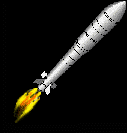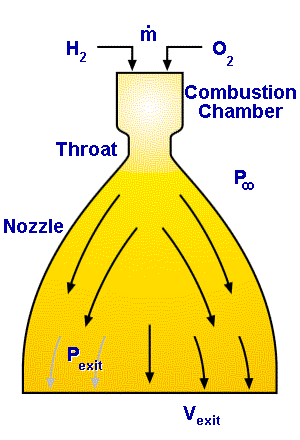How Does a Rocket Work?
 Rockets are a simple case of Newtonian Physics...
Rockets are a simple case of Newtonian Physics...
Action -> Reaction!
When a rocket's fuel ignites, the molecules in the fuel release a tremendous amount of energy in the forms of heat, light, and sound. They expand rapidly as they move from the "throat" of the nozzle into the "bell." Consider the balloon below:
(diagram by Tess Caswell)
The compressed air inside the balloon wants to expand outward (pink force vectors). Therefore it presses against the walls of the balloon in every direction except the place where there is no wall - the "nozzle" of the balloon. Because there is no force vector in this location, adding the vectors yields a net force to the right (red arrow).
The more complicated diagram below shows a bell nozzle, where a fuel (liquid Hydrogen) mixes with an oxidizer (liquid Oxygen) at a rate "m." As they ignite they are forced into the throat, where they are compressed substantially. As they move out into the bell, they steadily expand, pushing against the nozzle and creating a net upward thrust, similar to the compressed air pushing on the walls of the balloon. Luckily, a rocket can be controlled more than a released balloon!

diagram courtesy (Aerospaceweb.org/Rocketdyne Corp. 1995)
Nozzles do not have to be bell shaped - as long as gas is expanding and pushing against a surface, creating thrust, any shape can be used! This website explores one alternative to the bell engine - the spike configuration. In particular, the Aerospike engine will be described and analyzed.
| Back to Home | Spike Engines | The Aerospike | Bibliography |